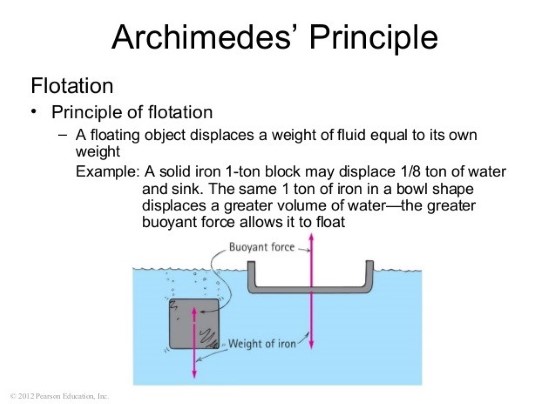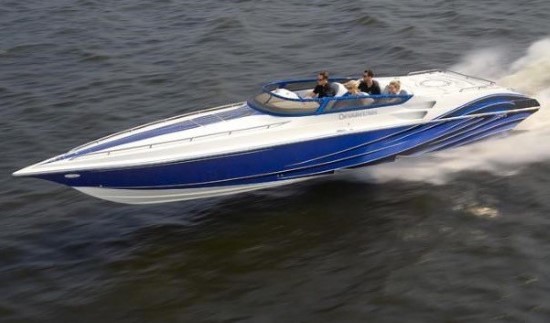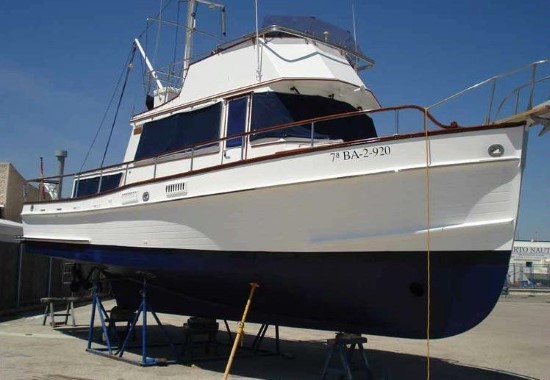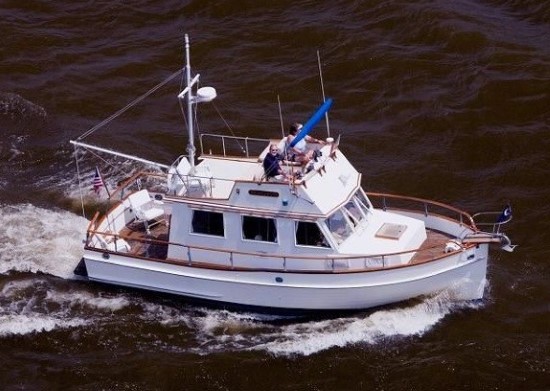Boat Buying Tips: Go Light, or Go Heavy?

Is It Weight, or Displacement?
Archimedes of Syracuse was a mathematician, physicist and engineer – and maybe a boat designer, too. In around 250 B.C., he wrote On Floating Bodies, the first known work on hydrostatics. Archimedes explained that, in order for a body, or a boat, to float, the boat must displace its own weight of water.
That's Archimedes' Principle. Everybody interested in boats knows it, and it's a hint as to why naval architects often use "displacement" rather than "weight": They're concerned with the volume of water a boat displaces when floating on her designed waterline. That volume determines the boat's allowable weight.

The weight of a given boat doesn't change, as long as she remains on this planet, but her displacement can. Why? When a naval architect draws a hull, he/she determines where the waterline should be, and calculates the underwater volume of the hull. This is how much water the boat will displace, in cubic feet, when floating on her designed waterline.
To make the math easy, let's assume a boat’s displacement is 100 cu. ft. Saltwater weighs 64 lb./cu. ft., so for the boat to float as designed, she'll have to weigh 100 cu. ft x 64 lb. or 6,400 lb. (2,903 kg) in saltwater.

Fresh water weighs 62.5 lb./cu. ft., so if the same boat is moved to a freshwater lake, she'll either have to trim down to 6,250 lb. (2,835 kg) or float a bit lower and displace a bit more water – 2.4 cu. ft. more, for those keeping score. Her displacement in fresh water is different than in salt, although her weight hasn't changed. That's not enough difference to worry about, but it explains why the owner will have to raise the waterline slightly when he relocates from Florida to the Great Lakes.
What's Better: Light or Heavy?
Designing a boat involves many factors that have to be balanced: length, beam, draft, weight, accommodations, power, etc. Which factors are most important depend on what the designer's trying to achieve. If it is maximum speed, light weight is crucial; if it's long range for cruising, not so much – the ability to carry lots of stuff and plenty of fuel is more important. Comparing boats based on weight demands that the boats be very similar.

Lightweight Advantage. When it comes to performance, power-to-weight ratio is the main determinant: If two boats are similar, the one with more horsepower per pound will almost always be faster. Boat buyers looking for speed above all else should look for light weight relative to horsepower. Divide the weight of the boat by the total shaft hp. to find pounds/hp. Use the weight listed in the specs; boats are always heavier in use, but by how much depends on fuel levels, gear levels, weight of crew, etc. It's almost impossible to measure this accurately, so use spec weight, which has been calculated by the designer. For example, a Formula FASTech 353 we tested weighs 9,500 lb. (4,309 kg) according to the specs; our test boat had twin 525-hp MerCruisers. Crunch these numbers to get 9.05 lb./hp., indicative of a very fast boat.
Heavyweight Advantage. However, a very light, very fast boat can be squirrely to handle in rough water, so unless a boat buyer is skilled at handling high-performance boats, a bit of extra weight and a little less top speed is frequently the best choice. A heavier boat is more comfortable in any kind of chop, easier on the crew and, chances are, not much slower at cruise speeds. Top speed is nice for bragging rights, but most of the time even a fire-breathing raceboat is throttled back. We'd opt for a heavier, more comfortable boat.

What About Low-Speed Handling?
Think about the difference between driving a golf ball off the tee and then whacking a cue ball, or a baseball, or a bowling ball with the same No. 3 wood. The heavier balls, with lots more inertia than the golf ball, will absorb way more of the power of the club head before moving. (Something tells us the bowling ball won't move at all.) And the same is true for a boat: Replace the golf club with a gust of wind, the various balls with boats of increasing weight. A heavier boat is less susceptible to wind when operating at slow speed, e.g., around the marina. A wind gust that'll hardly affect a beefy express cruiser or trawler, for example, will send a lightweight performance boat or bowrider skittering away downwind, usually to the embarrassment of her skipper.

Many skippers accustomed to docking big, heavy boats, even those that aren't especially light on their keels, have trouble coaxing small, lightweight vessels into their berths. Why? Lighter boats react quickly to wind, while bigger, heavier hulls with more inertia stay put longer. The difference is even greater when the heavier boat has a deeper hull, with more underwater volume – that's why it's easier to dock a big trawler than it is a speedboat if there's any wind at all.

Are Heavier Boats Better Built?
There's a misapprehension among many boaters that heavier boats are better built, but that's not necessarily true. Modern materials and boatbuilding methods – Kevlar, carbon fiber, cored laminates, vacuum-bagging, etc. – produce lightweight boats that are stronger than older-technology fiberglass hulls of a generation ago. We'd rely more on the builder's reputation than on the weight of the boat when evaluating strength. And most of a boat's weight isn't structure, anyway, but engines, hardware, systems, furniture and so forth.

Solid-laminate hulls might have the advantage in impact resistance, since they're thicker. Cored hulls have a thinner outer fiberglass skin that's easier to puncture. And solid laminates are easier to repair, a consideration for boaters planning to head off on long cruises far from qualified boatyards; with some training, anyone who's not all thumbs can repair a solid 'glass boat, at least well enough to get to professional help.

So the bottom line is this: Weight plays a role in a boat's performance and handling, but whether more displacement is a plus or minus depends on what a boater is looking for. Speed? Less weight. Comfort and handling? More weight. Sturdy construction? Choose modern materials and methods, don't worry about the weight. In short, there are more important things to think about, and we'll address them in upcoming articles.